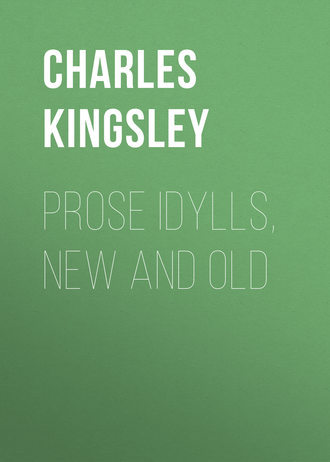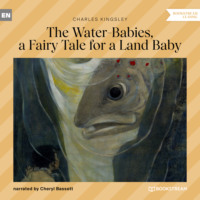 полная версия
полная версияProse Idylls, New and Old
‘But I cannot get below the pool without—’
Without crawling through that stiff stubbed hedge, well set with trees, and leaping that ten-foot feeder afterwards. Very well. It is this sort of thing which makes the stay-at-home cultivated chalk-fishing as much harder work than mountain angling, as a gallop over a stiffly enclosed country is harder than one over an open moor. You can do it or not, as you like: but if you wish to catch large trout on a bright day, I should advise you to employ the only method yet discovered.
There—you are through; and the keeper shall hand you your rod. You have torn your trousers, and got a couple of thorns in your shins. The one can be mended, the other pulled out. Now, jump the feeder. There is no run to it, so—you have jumped in. Never mind: but keep the point of your rod up. You are at least saved the lingering torture of getting wet inch by inch; and as for cold water hurting any one—Credat Judæus.
Now make a circuit through the meadow forty yards away. Stoop down when you are on the ridge of each table. A trout may be basking at the lower end of the pool, who will see you, rush up, and tell all his neighbours. Take off that absurd black chimney-pot, which you are wearing, I suppose, for the same reason as Homer’s heroes wore their koruthous and phalerous, to make yourself look taller and more terrible to your foes. Crawl up on three legs; and when you are in position, kneel down. So.
Shorten your line all you can—you cannot fish with too short a line up-stream; and throw, not into the oil-basin near you, but right up into the darkest corner. Make your fly strike the brickwork and drop in.—So? No rise? Then don’t work or draw it, or your deceit is discovered instantly. Lift it out, and repeat the throw.
What? You have hooked your fly in the hatches? Very good. Pull at it till the casting-line breaks; put on a fresh one, and to work again. There! you have him. Don’t rise! fight him kneeling; hold him hard, and give him no line, but shorten up anyhow. Tear and haul him down to you before he can make to his home, while the keeper runs round with the net . . . There, he is on shore. Two pounds, good weight. Creep back more cautiously than ever, and try again. . . . There. A second fish, over a pound weight. Now we will go and recover the flies off the hatches; and you will agree that there is more cunning, more science, and therefore more pleasant excitement, in ‘foxing’ a great fish out of a stop-hole, than in whipping far and wide over an open stream, where a half-pounder is a wonder and a triumph. As for physical exertion, you will be able to compute for yourself how much your back, knees, and fore-arm will ache by nine o’clock to-night, after some ten hours of this scrambling, splashing, leaping, and kneeling upon a hot June day. This item in the day’s work will of course be put to the side of loss or of gain, according to your temperament: but it will cure you of an inclination to laugh at us Wessex chalk-fishers as Cockneys.
So we will wander up the streams, taking a fish here and a fish there, till—Really it is very hot. We have the whole day before us; the fly will not be up till five o’clock at least; and then the real fishing will begin. Why tire ourselves beforehand? The squire will send us luncheon in the afternoon, and after that expect us to fish as long as we can see, and come up to the hall to sleep, regardless of the ceremony of dressing. For is not the green drake on? And while he reigns, all hours, meals, decencies, and respectabilities must yield to his caprice. See, here he sits, or rather tens of thousands of him, one on each stalk of grass—green drake, yellow drake, brown drake, white drake, each with his gauzy wings folded over his back, waiting for some unknown change of temperature, or something else, in the afternoon, to wake him from his sleep, and send him fluttering over the stream; while overhead the black drake, who has changed his skin and reproduced his species, dances in the sunshine, empty, hard, and happy, like Festus Bailey’s Great Black Crow, who all his life sings ‘Ho, ho, ho,’
‘For no one will eat him,’ he well doth know.However, as we have insides, and he has actually none, and what is more strange, not even a mouth wherewith to fill the said insides, we had better copy his brothers and sisters below whose insides are still left, and settle with them upon the grass awhile beneath you goodly elm.
Comfort yourself with a glass of sherry and a biscuit, and give the keeper one, and likewise a cigar. He will value it at five times its worth, not merely for the pleasure of it, but because it raises him in the social scale. ‘Any cad,’ so he holds, ‘smokes pipes; but a good cigar is the mark of the quality,’ and of them who ‘keep company with the quality,’ as keepers do. He puts it in his hat-crown, to smoke this evening in presence of his compeers at the public-house, retires modestly ten yards, lies down on his back in a dry feeder, under the shade of the long grass, and instantly falls fast asleep. Poor fellow! he was up all last night in the covers, and will be again to-night. Let him sleep while he may, and we will chat over chalk-fishing.
The first thing, probably, on which you will be inclined to ask questions, is the size of the fish in these streams. We have killed this morning four fish averaging a pound weight each. All below that weight we throw in, as is our rule here; but you may have remarked that none of them exceeded half a pound; that they were almost all about herring size. The smaller ones I believe to be year-old fish, hatched last spring twelvemonth; the pound fish two-year-olds. At what rate these last would have increased depends very much, I suspect, on their chance of food. The limit of life and growth in cold-blooded animals seems to depend very much on their amount of food. The boa, alligator, shark, pike, and I suppose the trout also, will live to a great age, and attain an enormous size, give them but range enough; and the only cause why there are trout of ten pounds and more in the Thames lashers, while one of four pounds is rare here, is simply that the Thames fish has more to eat. Here, were the fish not sufficiently thinned out every year by anglers, they would soon become large-headed, brown, and flabby, and cease to grow. Many a good stream has been spoilt in this way, when a squire has unwisely preferred quantity to quality of fish.
And if it be not the quantity of feed, I know no clear reason why chalk and limestone trout should be so much larger and better flavoured than any others. The cause is not the greater swiftness of the streams; for (paradoxical as it may seem to many) a trout likes swift water no more than a pike does, except when spawning or cleaning afterwards. At those times his blood seems to require a very rapid oxygenation, and he goes to the ‘sharps’ to obtain it: but when he is feeding and fattening, the water cannot be too still for him. Streams which are rapid throughout never produce large fish; and a hand-long trout transferred from his native torrent to a still pond, will increase in size at a ten times faster rate. In chalk streams the largest fish are found oftener in the mill-heads than in the mill tails. It is a mistake, though a common one, to fancy that the giant trout of the Thames lashers lie in swift water. On the contrary, they lie in the very stillest spot of the whole pool, which is just under the hatches. There the rush of the water shoots over their heads, and they look up through it for every eatable which may be swept down. At night they run down to the fan of the pool, to hunt minnow round the shallows; but their home by day is the still deep; and their preference of the lasher pool to the quiet water above is due merely to the greater abundance of food. Chalk trout, then, are large not merely because the water is swift.
Whether trout have not a specific fondness for lime; whether water of some dozen degrees of hardness is not necessary for their development? are questions which may be fairly asked. Yet is not the true reason this; that the soil on the banks of a chalk or limestone stream is almost always rich—red loam, carrying an abundant vegetation, and therefore an abundant crop of animal life, both in and out of the water? The countless insects which haunt a rich hay meadow, all know who have eyes to see; and if they will look into the stream they will find that the water-world is even richer than the air-world.
Every still spot in a chalk stream becomes so choked with weed as to require moving at least thrice a year, to supply the mills with water. Grass, milfoil, water crowfoot, hornwort, starwort, horsetail, and a dozen other delicate plants, form one tangled forest, denser than those of the Amazon, and more densely peopled likewise.
To this list will soon be added our Transatlantic curse, Babingtonia diabolica, alias Anacharis alsin astrum. It has already ascended the Thames as high as Reading; and a few years more, owing to the present aqua-vivarium mania, will see it filling every mill-head in England, to the torment of all millers. Young ladies are assured that the only plant for their vivariums is a sprig of anacharis, for which they pay sixpence—the market value being that of a wasp, flea, or other scourge of the human race; and when the vivarium fails, its contents, Anacharis and all, are tost into the nearest ditch; for which the said young lady ought to be fined five pounds; and would be, if Governments governed. What an ‘if’.
But come; for the sun burns bright, and fishing is impossible: lie down upon the bank, above this stop. There is a campshutting (a boarding in English) on which you can put your elbows. Lie down on your face, and look down through two or three feet of water clear as air into the water forest where the great trout feed.
Here; look into this opening in the milfoil and crowfoot bed. Do you see a grey film around that sprig? Examine it through the pocket lens. It is a forest of glass bells, on branching stalks. They are Vorticellæ; and every one of those bells, by the ciliary current on its rim, is scavenging the water—till a tadpole comes by and scavenges it. How many millions of living creatures are there on that one sprig? Look here!—a brown polype, with long waving arms—a gigantic monster, actually a full half-inch long. He is Hydra fusca, most famous, and earliest described (I think by Trembley). Ere we go home I may show you perhaps Hydra viridis, with long pea-green arms; and rosea, most beautiful in form and colour of all the strange family. You see that lump, just where his stalk joins his bell-head? That is a budding baby. Ignorant of the joys and cares of wedlock, he increases by gemmation. See! here is another, with a full-sized young one growing on his back. You may tear it off if you will—he cares not. You may cut him into a dozen pieces, they say, and each one will grow, as a potato does. I suppose, however, that he also sends out of his mouth little free ova—medusoids—call them what you will, swimming by ciliæ, which afterwards, unless the water beetles stop them on the way, will settle down as stalked polypes, and in their turn practise some mystery of Owenian parthenogenesis, or Steenstruppian alternation of generations, in which all traditional distinctions of plant and animal, male and female, are laughed to scorn by the magnificent fecundity of the Divine imaginations.
That dusty cloud which shakes off in the water as you move the weed, under the microscope would be one mass of exquisite forms—Desmidiæ and Diatomaceæ, and what not? Instead of running over long names, take home a little in a bottle, put it under your microscope, and if you think good verify the species from Hassall, Ehrenberg, or other wise book; but without doing that, one glance through the lens will show you why the chalk trout grow fat.
Do they, then, eat these infusoria?
That is not clear. But minnows and small fry eat them by millions; and so do tadpoles, and perhaps caddis baits and water crickets.
What are they?
Look on the soft muddy bottom. You see numberless bits of stick. Watch awhile, and those sticks are alive, crawling and tumbling over each other. The weed, too, is full of smaller ones. Those live sticks are the larva-cases of the Caperers—Phryganeæ—of which one family nearly two hundred species have been already found in Great Britain. Fish up one, and you find, amid sticks and pebbles, a comfortable silk case, tenanted by a goodly grub. Six legs he has, like all insects, and tufts of white horns on each ring of his abdomen, which are his gills. A goodly pair of jaws he has too, and does good service with them: for he is the great water scavenger. Decaying vegetable matter is his food, and with those jaws he will bark a dead stick as neatly as you will with a penknife. But he does not refuse animal matter. A dead brother (his, not yours) makes a savoury meal for him; and a party of those Vorticellæ would stand a poor chance if he came across them. You may count these caddis baits by hundreds of thousands; whether the trout eat them case and all, is a question in these streams. In some rivers the trout do so; and what is curious, during the spring, have a regular gizzard, a temporary thickening of the coats of the stomach, to enable them to grind the pebbly cases of the caddises. See! here is one whose house is closed at both ends—‘grillé,’ as Pictet calls it, in his unrivalled monograph of the Genevese Phryganeæ, on which he spent four years of untiring labour. The grub has stopped the mouth of his case by an open network of silk, defended by small pebbles, through which the water may pass freely, while he changes into his nymph state. Open the case; you find within not a grub, but a strange bird-beaked creature, with long legs and horns laid flat by its sides, and miniature wings on its back. Observe that the sides of the tail, and one pair of legs, are fringed with dark hairs. After a fortnight’s rest in this prison this ‘nymph’ will gnaw her way out and swim through the water on her back, by means of that fringed tail and paddles, till she reaches the bank and the upper air. There, under the genial light of day, her skin will burst, and a four-winged fly emerge, to buzz over the water as a fawn-coloured Caperer—deadliest of trout flies; if she be not snapped up beforehand under water by some spotted monarch in search of supper.
But look again among this tangled mass of weed. Here are more larvæ of water-flies. Some have the sides fringed with what look like paddles, but are gills. Of these one part have whisks at the tail, and swim freely. They will change into ephemeræ, cock-winged ‘duns,’ with long whisked tails. The larvæ of the famous green drake (Ephemera vulgata) are like these: but we shall not find them. They are all changed by now into the perfect fly; and if not, they burrow about the banks, and haunt the crayfish-holes, and are not easily found.
Some, again, have the gills on their sides larger and broader, and no whisks at the tail. These are the larvæ of Sialis, the black alder, Lord Stowell’s fly, shorm fly, hunch-back of the Welsh, with which we have caught our best fish to-day.
And here is one of a delicate yellow-green, whose tail is furnished with three broad paddle-blades. These, I believe, are gills again. The larva is probably that of the Yellow Sally—Chrysoperla viridis—a famous fly on hot days in May and June. Among the pebbles there, below the fall, we should have found, a month since, a similar but much larger grub, with two paddles at his tail. He is the ‘creeper’ of the northern streams, and changes to the great crawling stone fly (May-fly of Tweed), Perla bicaudata, an ugly creature, which runs on stones and posts, and kills right well on stormy days, when he is beaten into the stream.
There. Now we have the larvæ of the four great trout-fly families, Phryganeæ, Ephemeræ, Sialidæ, Perlidæ; so you have no excuse for telling—as not only Cockneys, but really good sportsmen who write on fishing, have done—such fibs as that the green drake comes out of a caddis-bait, or giving such vague generalities as, ‘this fly comes from a water-larva.’
These are, surely, in their imperfect and perfect states, food enough to fatten many a good trout: but they are not all. See these transparent brown snails, Limneæ and Succinæ, climbing about the posts; and these other pretty ones, coil laid within coil as flat as a shilling, Planorbis. Many a million of these do the trout pick off the weed day by day; and no food, not even the leech, which swarms here, is more fattening. The finest trout of the high Snowdon lakes feed almost entirely on leech and snail—baits they have none—and fatten till they cut as red as a salmon.
Look here too, once more. You see a grey moving cloud about that pebble bed, and underneath that bank. It is a countless swarm of ‘sug,’ or water-shrimp; a bad food, but devoured greedily by the great trout in certain overstocked preserves.
Add to these plenty of minnow, stone-loach, and miller’s thumbs, a second course of young crayfish, and for one gormandizing week of bliss, thousands of the great green-drake fly: and you have food enough for a stock of trout which surprise, by their size and number, an angler fresh from the mountain districts of the north and west. To such a fisherman, the tale of Mr. ** *, of Ramsbury, who is said to have killed in one day in his own streams on Kennet, seventy-six trout, all above a pound, sounds like a traveller’s imagination: yet the fact is, I believe, accurately true.
This, however, is an extraordinary case upon an extraordinary stream. In general, if a man shall bring home (beside small fish) a couple of brace of from one to three pounds apiece, he may consider himself as a happy man, and that the heavens have not shone, but frowned, upon him very propitiously.
And now comes another and an important question. For which of all these dainty eatables, if for any, do the trout take our flies? and from that arises another. Why are the flies with which we have been fishing this morning so large—of the size which is usually employed on a Scotch lake? You are a North-country fisher, and are wont, upon your clear streams, to fish with nothing but the smallest gnats. And yet our streams are as clear as yours: what can be clearer?
Whether fish really mistake our artificial flies for different species of natural ones, as Englishmen hold; or merely for something good to eat, the colour whereof strikes their fancy, as Scotchmen think—a theory which has been stated in detail, and with great semblance of truth, in Mr. Stewart’s admirable ‘Practical Angler,’—is a matter about which much good sense has been written on both sides.
Whosoever will, may find the great controversy fully discussed in the pages of Ephemera. Perhaps (as in most cases) the truth lies between the two extremes; at least, in a chalk-stream.
Ephemera’s list of flies may be very excellent, but it is about ten times as long as would be required for any of our southern streams. Six or seven sort of flies ought to suffice for any fisherman; if they will not kill, the thing which will kill is yet to seek.
To name them:—
1. The caperer.
2. The March-brown.
3. The governor.
4. The black alder.
And two or three large palmers, red, grizzled, and coch-a-bonddhu, each with a tuft of red floss silk at the tail. These are enough to show sport from March to October; and also like enough to certain natural flies to satisfy the somewhat dull memory of a trout.
But beyond this list there is little use in roaming, as far as my experience goes. A yellow dun kills sometimes marvellously on chalk-streams, and always upon rocky ones. A Turkey-brown ephemera, the wing made of the bright brown tail of the cock partridge, will, even just after the May-fly is off, show good sport in the forenoon, when he is on the water; and so will in the evening the claret spinner, to which he turns. Excellent patterns of these flies may be found in Ronalds: but, after all, they are uncertain flies; and, as Harry Verney used to say, ‘they casualty flies be all havers;’ which sentence the reader, if he understands good Wessex, can doubtless translate for himself.
And there are evenings on which the fish take greedily small transparent ephemeræ. But, did you ever see large fish rise at these ephemeræ? And even if you did, can you imitate the natural fly? And after all, would it not be waste of time? For the experience of many good fishers is, that trout rise at these delicate duns, black gnats, and other microscopic trash, simply faute de mieux. They are hungry, as trout are six days in the week, just at sunset. A supper they must have, and they take what comes; but if you can give them anything better than the minute fairy, compact of equal parts of glass and wind, which naturalists call an Ephemera or Bætis, it will be most thankfully received, if there be ripple enough on the water (which there seldom is on a fine evening) to hide the line: and even though the water be still, take boldly your caperer or your white moth (either of them ten times as large as what the trout are rising at), hurl it boldly into a likely place, and let it lie quiet and sink, not attempting to draw or work it; and if you do not catch anything by that means, comfort yourself with the thought that there are others who can.
And now to go through our list, beginning with—
1. The caperer.
This perhaps is the best of all flies; it is certainly the one which will kill earliest and latest in the year; and though I would hardly go as far as a friend of mine, who boasts of never fishing with anything else, I believe it will, from March to October, take more trout, and possibly more grayling, than any other fly. Its basis is the woodcock wing; red hackle legs, which should be long and pale; and a thin mohair body, of different shades of red-brown, from a dark claret to a pale sandy. It may thus, tied of different sizes, do duty for half-a-dozen of the commonest flies; for the early claret (red-brown of Ronalds; a Nemoura, according to him), which is the first spring-fly; for the red spinner, or perfect form of the March-brown ephemera; for the soldier, the soft-winged reddish beetle which haunts the umbelliferous flowers, and being as soft in spirit as in flesh, perpetually falls into the water, and comes to grief therein; and last but not least, for the true caperers, or whole tribe of Phryganidæ, of which a sketch was given just now. As a copy of them, the body should be of a pale red brown, all but sandy (but never snuff-coloured, as shop-girls often tie it), and its best hour is always in the evening. It kills well when fish are gorged with their morning meal of green drakes; and after the green drake is off, it is almost the only fly at which large trout care to look; a fact not to be wondered at when one considers that nearly two hundred species of English Phryganidæ have been already described, and that at least half of them are of the fawn-tint of the caperer. Under the title of flame-brown, cinnamon, or red-hackle and rail’s wing, a similar fly kills well in Ireland, and in Scotland also; and is sometimes the best sea-trout fly which can be laid on the water. Let this suffice for the caperer.
2. Of the March-brown ephemera there is little to be said, save to notice Ronalds’ and Ephemera’s excellent description, and Ephemera’s good hint of fishing with more than one March-brown at once, viz., with a sandy-bodied male, and a greenish-bodied female. The fly is a worthy fly, and being easily imitated, gives great sport, in number rather than in size; for when the March-brown is out, the two or three pound fish are seldom on the move, preferring leeches, tom-toddies, and caddis-bait in the nether deeps, to slim ephemeræ at the top; and if you should (as you may) get hold of a big fish on the fly, ‘you’d best hit him in again,’ as we say in Wessex; for he will be, like the Ancient Mariner—
‘Long, and lank, and brown,As is the ribbed sea-sand.’3. The ‘governor.’—In most sandy banks, and dry poor lawns, will be found numberless burrows of ground bees who have a great trick of tumbling into the water. Perhaps, like the honey bee, they are thirsty souls, and must needs go down to the river and drink; perhaps, like the honey bee, they rise into the air with some difficulty, and so in crossing a stream are apt to strike the further bank, and fall in. Be that as it may, an imitation of these little ground bees is a deadly fly the whole year round; and if worked within six inches of the shore, will sometimes fill a basket when there is not a fly on the water or a fish rising. There are those who never put up a cast of flies without one; and those, too, who have killed large salmon on him in the north of Scotland, when the streams are low.











